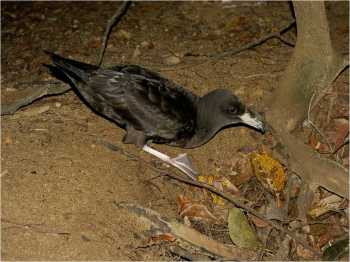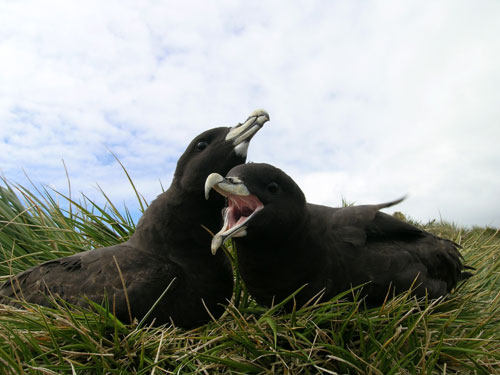News from the Australasian Seabird Group’s on-line discussion group is that globally Near Threatened Flesh-footed Ardenna carnepeis and Wedge-tailed A. pacifica (Least Concern) Shearwaters on Australia’s Lord Howe Island have had a very poor breeding season.

Flesh-footed Shearwater, photograph by Barry Baker
Jann Gilbert (National Marine Science Centre, Southern Cross University) has written to the ASG listserv:
“In one of the hottest summers on record for Lord Howe, which included a 3-month drought, it appears that egg laying was delayed some 4-6 weeks, and there was high chick mortality during the season. Some of this was following a weather event at the beginning of March (prior to cyclone Debbie), which dumped almost 200 mm of rain over 10 days and was accompanied by winds of up to 83 km/h. This was followed by cyclone Debbie at the tail-end of the breeding season. Consequently, most fledglings are not well-enough developed to fledge and, of the limited number that are, many are emaciated, and contain plastic.”
Lord Howe’s shearwaters face threats at sea from both ingesting plastic particles and longline fishing and on land from introduced rodents. Long-term plans to eradicate Black Rats Rattus rattus on Lord Howe, a World Heritage site since 1982, have not as yet come to fruition (click here and here) but it now seems likely the poison bait drop will take place during 2018.
Read and watch a video clip about nationally Vulnerable Flesh-footed Shearwater studies on New Zealand islands here.
ACAP has identified both the Flesh-footed and Wedge-tailed Shearwaters as potential candidates for listing within the Agreement. To date, two shearwater species, Pink-footed A. creatopus and Balearic Puffinus mauretanicus, are ACAP-listed.
Selected Literature:
Baker, G.B. & Wise, B.S. 2005. The impact of pelagic longline fishing on the flesh-footed shearwater Puffinus carneipes in Eastern Australia. Biological Conservation 126: 306-316.
Cooper, J. & Baker, G.B. 2008. Identifying candidate species for inclusion within the Agreement on the Conservation of Albatrosses and Petrels. Marine Ornithology 36: 1-8.
Hutton, I., Carlile, N. & Priddel, D. 2008. Plastic ingestion by Flesh-footed Shearwaters, Puffinus carneipes, and Wedge-tailed Shearwaters, Puffinus pacificus. Papers and Proceedings of the Royal Society of Tasmania 142: 67-72.
Lavers, J.L., Bond, A.L. & Hutton, I. 2014. Plastic ingestion by Flesh-footed Shearwaters (Puffinus carneipes): Implications for fledgling body condition and the accumulation of plastic-derived chemicals. Environmental Pollution 187: 124-129.
Priddel, D., Carlile, N., Fullager, P., Hutton, I. & O’Neill, L. 2006. Decline in the distribution and abundance of the flesh-footed shearwaters (Puffinus carneipes) on Lord Howe Island, Australia. Biological Conservation 128: 412-424.
Reid, T.A., Hindell, M.A., Lavers, J.L. & Wilcox, C. 2013. Re-examining mortality sources and population trends in a declining seabird: using Bayesian methods to incorporate existing information and new data. PLoS ONE. doi:10.1371/journal.pone.0058230.
John Cooper, ACAP Information Officer, 16 May 2017

 English
English  Français
Français  Español
Español 


